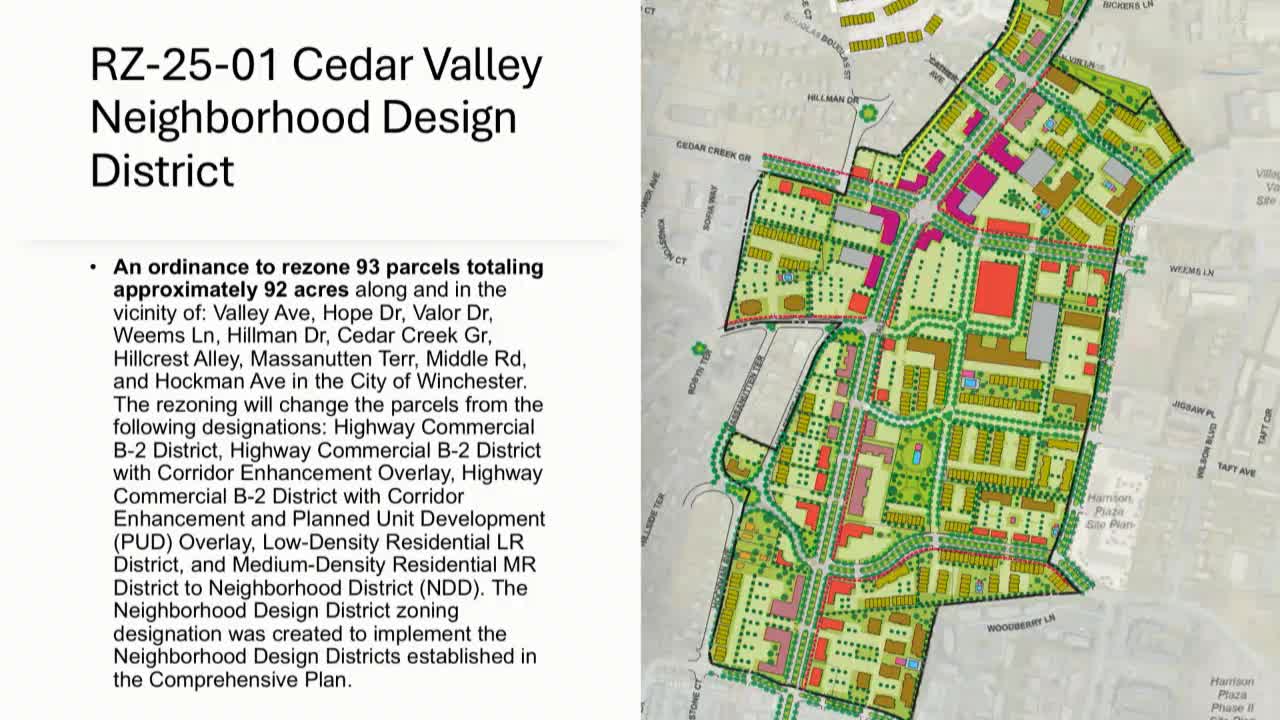Commission reviews city-sponsored rezoning to create Cedar Valley Neighborhood Design District
May 06, 2025 | Winchester City, Frederick County, Virginia
This article was created by AI summarizing key points discussed. AI makes mistakes, so for full details and context, please refer to the video of the full meeting. Please report any errors so we can fix them. Report an error »

The Planning Commission reviewed a city-sponsored rezoning ordinance (RZ2501) to rezone about 93 parcels totaling roughly 92 acres in the Cedar Valley area to a Neighborhood Design District (NDD).
Daniel Reddy, planning staff, described the item as a technical but final step in implementing the comprehensive plan’s neighborhood design districts. “The area is most definitely a catalyst area, an area where we want to see change, and this zoning change helps us implement that,” Reddy said, outlining that the proposal would convert a mix of current designations — including B-2 highway commercial with corridor enhancement overlay, low- and medium-density residential, and some PUD overlays — into an NDD zoning classification intended to promote a flexible mix of residential and commercial uses.
Reddy said the NDD combines features of downtown and corridor zoning to encourage mixed-use, new-urbanism development and create a focal center for activity. He pointed out that previously approved planned-unit developments (PUDs), such as Wards Plaza, would remain subject to their existing approvals and would not automatically be governed by the NDD development standards.
Commissioners asked why only portions of some larger projects — including the front portion of the Elms/Ward Plaza area — were included. Commissioner Pfeiffer asked, “What was the purpose of not rezoning the whole Elms of that whole development…?” Reddy said the boundary decisions were made by the neighborhood design district committee to focus redevelopment where it would most effectively catalyze change, and to avoid encroaching on stable single-family neighborhoods. He noted including the front portion of the Elms helped make some redevelopment and remediation financing available for the property.
Commissioner Deck asked about owner notification. Reddy said state code requires notification to all property owners; the city additionally notified properties within 300 feet of the boundary, and the item was advertised in the newspaper. Questions about Tax Increment Financing (TIF) followed: staff said TIF or synthetic-TIF financing could be used to fund public improvements that support redevelopment, including sidewalks and stormwater work, and that public streets adjacent to the site could be eligible for those funds.
The commission treated the item as work-session review; Reddy said a public hearing on the city-sponsored ordinance will be held at the next Planning Commission meeting. No formal vote occurred at the work session.
Ending: Staff indicated the rezoning is intended to implement the city’s recently adopted comprehensive plan and to enable targeted redevelopment and public improvements; commissioners requested clarifications on boundaries and notifications before the public hearing.
Daniel Reddy, planning staff, described the item as a technical but final step in implementing the comprehensive plan’s neighborhood design districts. “The area is most definitely a catalyst area, an area where we want to see change, and this zoning change helps us implement that,” Reddy said, outlining that the proposal would convert a mix of current designations — including B-2 highway commercial with corridor enhancement overlay, low- and medium-density residential, and some PUD overlays — into an NDD zoning classification intended to promote a flexible mix of residential and commercial uses.
Reddy said the NDD combines features of downtown and corridor zoning to encourage mixed-use, new-urbanism development and create a focal center for activity. He pointed out that previously approved planned-unit developments (PUDs), such as Wards Plaza, would remain subject to their existing approvals and would not automatically be governed by the NDD development standards.
Commissioners asked why only portions of some larger projects — including the front portion of the Elms/Ward Plaza area — were included. Commissioner Pfeiffer asked, “What was the purpose of not rezoning the whole Elms of that whole development…?” Reddy said the boundary decisions were made by the neighborhood design district committee to focus redevelopment where it would most effectively catalyze change, and to avoid encroaching on stable single-family neighborhoods. He noted including the front portion of the Elms helped make some redevelopment and remediation financing available for the property.
Commissioner Deck asked about owner notification. Reddy said state code requires notification to all property owners; the city additionally notified properties within 300 feet of the boundary, and the item was advertised in the newspaper. Questions about Tax Increment Financing (TIF) followed: staff said TIF or synthetic-TIF financing could be used to fund public improvements that support redevelopment, including sidewalks and stormwater work, and that public streets adjacent to the site could be eligible for those funds.
The commission treated the item as work-session review; Reddy said a public hearing on the city-sponsored ordinance will be held at the next Planning Commission meeting. No formal vote occurred at the work session.
Ending: Staff indicated the rezoning is intended to implement the city’s recently adopted comprehensive plan and to enable targeted redevelopment and public improvements; commissioners requested clarifications on boundaries and notifications before the public hearing.
View full meeting
This article is based on a recent meeting—watch the full video and explore the complete transcript for deeper insights into the discussion.
View full meeting
